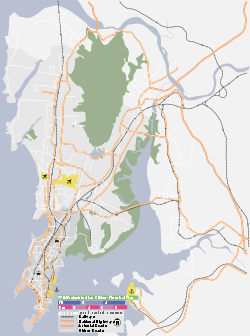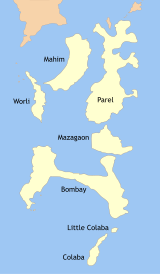- Mazagaon
-
Mazagaon — neighbourhood — Coordinates 18°58′N 72°51′E / 18.97°N 72.85°ECoordinates: 18°58′N 72°51′E / 18.97°N 72.85°E Country India State Maharashtra Time zone IST (UTC+05:30) Mazagaon, also spelled Mazgaon and Mazagon (Portuguese rule Mazagão[1]), and pronounced by the Catholics as 'Mazgon' or 'Maz-a-gon' and the Marathi-speakers as Mazhgav. It is one of the seven islands of Mumbai. It is part of South Mumbai and can be reached by Byculla Station on the Central railway line and Dockyard Road Station on the Harbour Railway line. Located in Mazagaon are maritime companies like the Bombay Port Trust and Mazagaon Dock Ltd., the Mazagaon Court and Anglo-Indian schools like the St. Peters School and St. Mary's School.
Contents
History
The word Mazagaon has been derived from the Sanskrit Matsya Gram, meaning fishing village. The original inhabitants were speculated to be tribals of Agari (salt-workers) and Koli (fishermen) tribes. However, folk etymology derives Mazagaon from the Marathi Maza Gaon, meaning my village. Another etymological claim suggests Portuguese origin, with the name borrowed from a city and fort of Mazagão in Morocco (now El Jadida) established by Portuguese in the beginning of the 16th century who totally evacuated to Brazil in 1769. One of Mazagaon's oldest claims to fame was a variety of mango trees which fruited twice a year. Apparently a few such trees were extant well into the 20th century. The small island was rocky, with a hill rising at the north, and forming a cliff over the harbour. To see what Mazagaon might once have been, one has to visit any of the tiny rocky islands bearing mango trees and small villages further down the Konkan coast.
The first Portuguese settlers were the Jesuits, who established a church in the 16th century. Notwithstanding their claim, in 1572 the King of Portugal granted the island in perpetuity to the de Souza e Lima family, from whom the D'Souzas of Mumbai trace their descent. When the Portuguese ceded the island to the British, there was a well established population of Roman Catholics, mainly fishermen. Most were Hindu converts, although Eurasians were not uncommon. Some black African slaves brought by the Portuguese, known as Kaffirs, had also entered the ethnic mix. Some of their traditional wooden houses can still be seen, and are now protected heritage structures.
The original Gloria church, Nossa Senhora da Glória, was built in 1632 from a donation by the de Souza family. It was destroyed in 1911, being replaced two years later by a new Gothic church of the same name built a kilometer away.
Mazagaon was occupied by the Sidi of Janjira, an admiral in the Mughal navy in 1690. It is said that he was driven away a year later by the Rustomji Dorabji, who organised the fishermen in Dongri into a fleet. Rustomji was given the title Patel after this feat, and his descendants have remained the only Parsi family of Patels.
With the reclamation of Umarkhadi, at the end of the 17th century, Mazagaon became an outlying suburb of Bombay and a fashionable place of residence. One of the famous houses was the neo-classical Tarala, built by a member of the Wadia family in the late 18th century. Sold to the Jeejeebhoy family about a century later, it became the Sadar Adalat in 1925, when they moved out to Malabar Hill. Later still it was taken over by the army, and then donated to the J. J. Hospital in 1943 after a fire. It was used as a staff hostel for a few years before it was demolished.
Other bungalows and plantations also grew up in Mazagaon as the British and the more affluent Indians moved out of the crowded fort. When the Esplanade was cleared in the Fort area, the armoury moved from Bombay Castle to Mazagaon in 1760 and gave its name to Gunpowder Lane. In 1790 the docks at Mazagaon were completed. In 1793, after the construction of the Hornby Vellard, the Bellasis Road was built to join Mazagaon and Malabar Hill.
The next century saw a slow decline in Mazagaon's fortunes, as the neighbouring Byculla became the fashionable suburb, and people began moving out. The process accelerated after the docks were reclaimed in the last thirty years of the century on the eastern shore of Mazagaon. Mazagaon was left landlocked, and the fumes from the developing mills drove the last money out of this area.
Among others, Tipu Sultan, the Mysore warrior's relative Nawab Ayaz Ali, migrated here after the British defeated the ruler in 1799 and was buried here.
The area
Once very fashionable, Mazgaon lost much of its charm after the more affluent British and Parsi residents relocated to Malabar Hill. Since independence, the area is generally considered to be a Catholic enclave. However, even though Mazagaon is still home to a large population of Catholics, Muslims (particularly Dawoodi Bohras ) are taking their place with most Catholics migrating abroad.Bohras are very rich people.Due to them large development is taking place in Mazgaon.Huge skycrappers of Bohra residents are being constructed.It has virtually become a Bohri-Muslim neighbourhood.A Catholic East Indian village can be found in the "Mathar Pakadi" area. The migrants originally from Goa set up transit camps, which later became permanent residences. The Goan Clubs are an integral part of this part of town. Nearby lie the famous Mazagaon Docks, famed as a site of ship building since the 18th century. It still builds warships for the Indian Navy and nearby is the Mazagaon Dock Colony which houses Angre house, Sarine house, Curry house and P & O Terrace. The Harbour Line station of Dockyard Road is the nearest railhead. The area is peaceful and quiet, unlike other parts of the city.
Churches in Mazagaon
Mazagaon is famous for its churches. Among the more prominent are:
- St. Anne's Church (Roman Catholic) (next to St. Mary's School),[1]
- Our Lady of the Rosary Church (Roman Catholic) in the East (opposite Dockyard Road Station),
- Our Lady of Glory Church (Roman Catholic) up north (in Byculla, opposite Byculla station),
- St. Joseph's Church (Roman Catholic) down south (in Umerkhadi, Dongri),
- St. Peter's Church (Protestant) (Non Functional) (near Mazagaon Hill)
- Protestant Church towards J.J. Hospital.
- Christ Church (Protestant) in the north.
- Methodist Churches near Victoria Gardens
- Methodist church opposite St. Agnes' School, Clare Road.
Important landmarks in Mazagaon (maza goan)
- St. Anne's Church [2]
- Seth Motisha Jain Temple, Love Lane
- St. Mary's School(ICSE) [3]
- St. Mary's High School, SSC [4]
- St. Peter's School, Mazagaon, ICSE
- Bombay Port Trust
- Chinese temple (the only one in the city)
- Framji Patel Parsi Agiary
- Joseph Baptista Garden and Reservoir now named Bhandar Wada Water Reservoir (built in 1880)
- Sales Tax Office
- M.D.L.(Mazagon Dock Limited )- Ship-Builders To The Nation
- Angre House (named after the Maratha Navy Kanhoji Angre)
- Shah Hasan Ali's Maqbara or Mausoleum (Hasanabad)
- Islamic International School , Operated by ISLAMIC RESEARCH FOUNDATION under the supervideon of Dr Zakir Naik.
Chinatown
See main article: Chinatown, Mumbai
Up to the 1960s Mumbai had a small Chinatown in Mazagaon. After the 1962 Sino-Indian War, most Chinese were viewed as traitors, and left the town.[2] Currently, Mumbai has a small ethnic Chinese population of 400 families.[3] The Chinese temple and cemetery are both located at Mazagaon.
References
- ^ D'Cunha, Jose Gerson (1900). "IV The Portuguese Period". The Origins of Bombay (3 ed.). Bombay: Asian Educational Services. pp. 265. ISBN 81-206-0815-1. http://books.google.co.in/books?id=miD5YO05jpUC&dq=the+origins+of+bombay. Retrieved 2009-01-04.
- ^ Abidi, S.N.M (2008-02-28). "Say sorry to the Indian Chinese". Khaleej Times.
- ^ Someshwar, Savera R (2007-01-23). "Happy Indian Chinese New Year". Rediff.com. http://www.rediff.com/news/2004/jan/23speca.htm. Retrieved 2008-10-08.
See also
Categories:- Neighbourhoods in Mumbai
- Islands of Mumbai
- History of Mumbai
Wikimedia Foundation. 2010.



